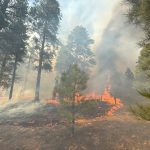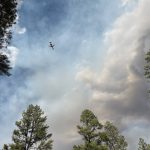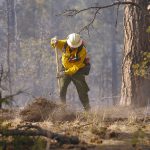
Why I chose to be a guinea pig, and how it went
CHINLE
I got the Pfizer-BioNTech coronavirus trial vaccine last Friday.
If you’re like my Facebook friends, you’re probably saying, “Wow, you’re very brave!”
I am pretty brave for an old lady, actually, but that’s not why I participated in the vaccine trial. The rest of you are actually much braver, considering one out of every 17 people on the Navajo Nation has or had COVID-19 (that we know of, with more cases reported every day), and the death rate, at 5.5 percent, is much higher than that of the nation as a whole.
I now have a chance of being protected from the virus (depending on whether I got a placebo or the actual vaccine, and whether the vaccine turns out to be effective), and of the 34,000 people who have taken it so far, only minor side effects have been reported, which is not true of the actual virus.
There are, of course, some good reasons not to participate in the vaccine trial that’s now going on all over the world, including the Navajo Nation.
The messenger RNA technology the vaccine uses is pretty new, and though on paper it’s much safer than using a killed or live virus and has been tried in animals since 1990, this is the first large-scale human trial.
My sister, a physician, noted that drug side effects sometimes pop up “years down the road” and urged me not to participate. But at 61, the road behind me is much longer than the road ahead, and I’m willing to take that risk.
As a public service, the Navajo Times is making all coverage of the coronavirus pandemic fully available on its website. Please support the Times by subscribing.
How to protect yourself and others.
Why masks work. Which masks are best.
Resources for coronavirus assistance
There are many completely vacuous reasons for avoiding the trial that have been floating around social media, such as that the vaccine “changes your DNA” (if that were true, your DNA would change every time you produced antibodies to fight off a cold) and that Bill Gates or someone else completely unaffiliated with the vaccine trial is using it as a chance to inject you with a tracking chip.
Got news for you folks: the Chinese government, international corporations and even casual users of Google Maps can track you any time they want to. Those tracking devices you voluntarily carry around in your pocket and use to post conspiracy theories are way more convenient for them, and cheaper, than some hypothetical microscopic electronics that would fit through a hypodermic needle.
So I thought I would share my experience as a lab rat with Navajo Times readers so they can make a more informed decision on whether or not to participate in this historic moment in international scientific discovery.
After giving my name, birth date and assurance that I wasn’t pregnant over the phone (pregnant or nursing women are barred from the trial), I was given an appointment to come to the Johns Hopkins office in Chinle last Thursday. I showed up a few minutes early and was asked to wait outside (as a COVID precaution) until they were ready for me.
They came for me promptly at 2 and ushered me into a room in the converted house trailer Hopkins uses as its Chinle base. Using a thick laminated flip chart, a research assistant walked me through the process of the trial, mentioning at least three times that it was entirely voluntary and I could opt out at any time.
I learned a little about the mRNA technology. The messenger RNA in the vaccine is sort of like a blueprint for the protein that exists on the “spikes” of the novel coronavirus. The spikes are what lodge in your lungs and cause the respiratory symptoms associated with the virus.
After your body starts producing the protein, it recognizes it as a pathogen and starts producing antibodies to fight it. The hope is that these antibodies will also repel the real coronavirus. That is what the researchers want to find out. They will track participants for two years to see if they develop antibodies, how long the antibodies last and see how many participants, using normal precautions, get the virus.
The research assistant explained that I would randomly be assigned to either the control group, which would get an injection of ordinary saline solution, or the study group, which would get the vaccine.
Neither I nor anyone at the Chinle site would know which group I fell into; I would be assigned a number that would be used by the team who would actually analyze the data. I would get a second “booster” in three weeks.
After that there would be follow-up visits with blood tests one month, six months, 12 months and 24 months after taking the vaccine.
In the meantime, any COVID symptoms, or any ill health that might be associated with the vaccine, should be immediately reported to Hopkins.
I would also have to track my temperature and keep a daily symptom diary on an app downloaded to my cell phone (if you don’t have a phone, they give you a device with the app on it).
There would be small stipends for getting the vaccine, making it to the follow-up appointments, and answering questions in the electronic diary to compensate me for my trouble.
She then assured me that if I decided not to participate, it would not affect my ability to get normal health care in the future (apparently this had been a concern of some participants).
After I assured her I still wanted to participate, she walked me through a lengthy contract and three additional forms that Hopkins could use to obtain medical records from my usual providers if they needed them. There was the usual exhaustive medical history stuff to fill out.
After signing, a doctor gave me a brief physical exam consisting of a blood pressure check, breathing and heart rate check, and a nasal swab to make sure I didn’t already have COVID-19.
Women of childbearing age are also required to pee in a cup for a pregnancy test, but thankfully they took my word that I was way past that. If you’re pregnant or plan to become pregnant within 28 days after your last injection, you’re automatically disqualified. Both men and women participants who are fertile and sexually active are required to use birth control consistently during that time.
After that I expected to get the vaccine, but the doctor told me I could come back Friday so I could let my decision settle overnight and make sure it’s what I wanted to do.
A whiteboard on the wall revealed I was the ninth person to sign up for the trial in Chinle (within the week the study had been in effect) and would be the fifth person to get a shot, but the doctor assured me 34,000 people around the world had already taken it, with only mild side effects like headache and fatigue so far.
The next day, I had my nose swabbed again and my blood drawn, to make sure I didn’t already have COVID antibodies from being previously exposed unawares. My blood pressure was taken again, as well as the heart rate and breathing exams, and I had to assure them I still wasn’t pregnant.
Then I had to wait a half-hour for the vaccine. Apparently they have to keep it at minus 70 degrees Celsius, so it takes a while to thaw out and for them to prepare it.
The actual vaccination was pretty anticlimactic. It took a few seconds, and was less painful than a flu shot.
I had to stay for another half-hour after the vaccine, with a nurse sitting with me in case I keeled over or sprouted a third arm or something, I guess. She was pleasant and we had a nice conversation during which she sneakily peppered in such questions as “Still feeling OK?” “How’s that injection site?”etc.
She did not seem like a corporate plant or a Chinese spy, but you never know, so I didn’t divulge any state secrets.
I suspect I got the saline, because normally even the flu vaccine throws me for a loop the rest of the day, but I felt fine. I asked her about the other participants. Were they first responders concerned about getting COVID?
“No,” she said. “They’re community members like you who want to help us develop a safe, effective vaccine so we can get this pandemic over with.”
I was kind of surprised because of all the hysterical anti-vaxer hype on the Times’ Facebook page, but the nurse assured me there are plenty of sane people who don’t feel compelled to post their whole lives on social media but are willing to step up and take a shot in the arm for science.
So far a steady stream of people has been calling to ask about the trial and Hopkins anticipates getting the couple hundred or so Navajo participants they need for a representative sample of the tribe.
The doctor who had given me my second examination explained they don’t anticipate Native Americans reacting any differently to the vaccine than people of other races, but you just never know until you do the trial.
“There are some minute genetic differences between races that could possibly make people react differently,” he said, “so the study is trying to get as diverse a population as possible.”
I felt good after I was finally determined to be OK and allowed to leave the hospital. I’ve been wanting to help with the pandemic, but by the time I get home from work I don’t have the energy to be driving around delivering food boxes, plus that seems like something that could be best left to the youngsters who are less at risk of getting the disease.
I’ve been donating to some of the GoFundMe accounts, but decades from now when my great-nieces and nephews ask me what I did during the pandemic, I don’t want to say, “I contributed to several GoFundMe accounts.”
So now when they ask me, “Great-Aunt Cindy, what did you do to help with the coronavirus pandemic?” I can proudly say, “I participated in the study for the vaccine you take every year to prevent you from getting it. And that’s why I have this third arm.”
Information: Chinle, 928-674-5051; Shiprock, 505-368-4030; Gallup, 505-722-6372; or johnshopkinscaih@gmail.com








 Highway 264,
Highway 264, I-40, WB @ Winslow
I-40, WB @ Winslow